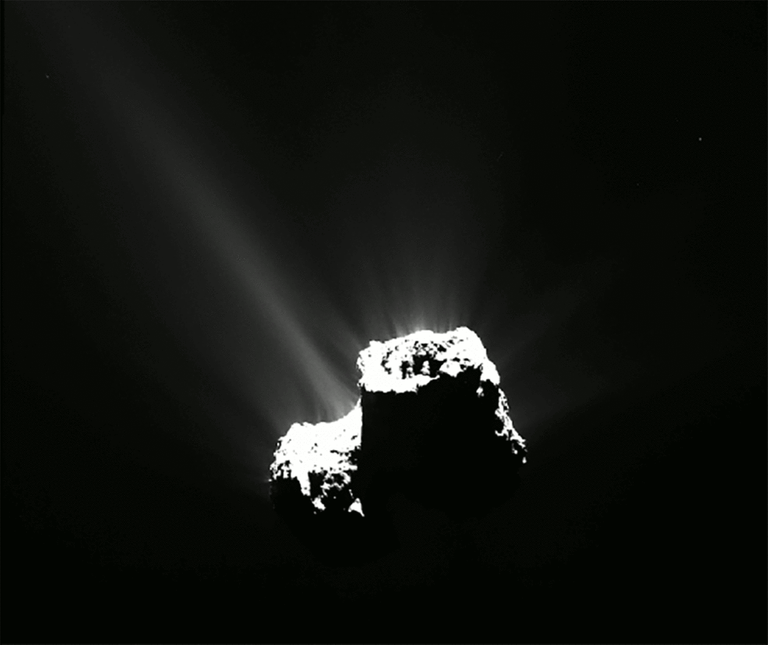Hello #Hivers, hope you all are doing good today. Today we are going to have a look on an unique comet discovered which is having its own Northern Lights. This is an amazing discovery in the field of space science. It is a very interesting topic to discuss about. So, without delaying anymore let us start our exploration within this article.

Image credit: ESA/Rosetta/NAVCAM (Source: NASA )
Comets are frozen excess from the arrangement of the solar system created out of dust, rock, and frosts. They run from one or two miles to tens miles wide, nevertheless as they orbit nearer to the sun, they heat up and heave gases and residue into a shining head which will be larger than a planet. This material structures a tail that extends a good many miles.
An atmospherical light show recently consigned to planets and Jupiter moons are found on comet utilizing information from ESA's Rosetta satellite.
Information from NASA instruments onboard the ESA (European Space Agency) Rosetta mission has uncovered that comet 67P/Churyumov-Gerasimenko has its far-ultraviolet. It is the first run through such electromagnetic discharges in the far-ultraviolet that have been reported on a divine article other than a planet or moon. A paper on the discoveries was delivered today in the diary Nature Astronomy.
On Earth, aurora (otherwise called the northern or southern lights) are produced when electrically charged particles speeding from the Sun hit the upper climate to make vivid shine of green, white, and red. Somewhere else in the close planetary system, Jupiter and a portion of its moons – just as Saturn, Uranus, Neptune, and even Mars – have all displayed their form of Aurora Borealis. Be that as it may, the wonders still couldn't seem to be archived in comets.
Rosetta is space investigation's generally voyaged and achieved comet tracker. Dispatched in 2004, it circled comet 67P/Churyumov-Gerasimenko (67P/C-G) from Aug. 2014 until its emotional finish of-mission comet arriving in Sept. 2016. The information for this latest examination is on what mission researchers at first deciphered as "dayglow," a cycle brought about by photons of light cooperating with the envelope of gas – known as the trance state – that transmits from and encompasses the comet's core. In any case, another investigation of the information paints an altogether different picture.
"The sparkle encompassing 67P/C-G is exceptional," said Marina Galand of Imperial College London and lead creator of the investigation.
The information demonstrates 67P/C-G's discharges are auroral. Electrons gushing out in the solar wind – the surge of charged particles streaming out from the Sun – communicate with the gas in the comet's extreme lethargies, breaking separated water and different atoms. The subsequent molecules emit a particular far-bright light. Undetectable to the unaided eye, far-bright has the most limited frequencies of radiation in the ultraviolet spectrum.
Investigating the emanation of 67P/C-G will empower researchers to figure out how the particles in the sun based breeze change after some time, something that is essential for understanding space climate all through the close planetary system. By giving better data on how the Sun's radiation influences the space condition they should go through, such data could eventually help secure satellites and rocket, just as space travelers heading out to the Moon and Mars.
"Rosetta is the blessing that continues giving," said Paul Feldman, a specialist on Alice at the Johns Hopkins University in Baltimore and a co-creator of the paper.
NASA Instruments Aboard ESA's Rosetta
NASA-provided instruments were added to this examination. The Ion and Electron Sensor (IES) instrument recognized the sum and vitality of electrons close to the rocket, the Alice instrument estimated the bright light radiated by the aurora, and the Microwave Instrument for the Rosetta Orbiter (MIRO) estimated the number of water atoms around the comet (the MIRO instrument incorporates commitments from France, Germany, and Taiwan). Different instruments onboard the rocket utilized in the examination were the Italian Space Agency's Visible and InfraRed Thermal Imaging Spectrometer (VIRTIS), the Langmuir Probe (LAP) gave by Sweden, and the Rosetta Orbiter Spectrometer for Ion and Neutral Analysis (ROSINA) gave by Switzerland.
A division of Caltech, NASA's Jet Propulsion Laboratory in Southern California dealt with the U.S. commitment of the Rosetta mission for NASA's Science Mission Directorate in Washington. JPL likewise constructed the MIRO and hosts its important agent, Mark Hofstadter. The Southwest Research Institute (San Antonio and Boulder, Colorado), built up the Rosetta orbiter's IES and Alice instruments and has their vital specialists, James Burch (IES) and Joel Parker (Alice).
Refernce:
- https://www.nasa.gov/feature/jpl/comet-discovered-to-have-its-own-northern-lights
- https://www.nanowerk.com/news2/space/newsid=56206.php
- https://solarsystem.nasa.gov/asteroids-comets-and-meteors/comets/overview/?page=0&per_page=40&order=name+asc&search=&condition_1=102%3Aparent_id&condition_2=comet%3Abody_type%3Ailike
Thanks for your contribution to the STEMsocial community. Feel free to join us on discord to get to know the rest of us!
Please consider supporting our funding proposal, approving our witness (@stem.witness) or delegating to the @stemsocial account (for some ROI).
Thanks for using the STEMsocial app and including @stemsocial as a beneficiary, which give you stronger support.
Congratulations @science-popper! You have completed the following achievement on the Hive blockchain and have been rewarded with new badge(s) :
You can view your badges on your board and compare yourself to others in the Ranking
If you no longer want to receive notifications, reply to this comment with the word
STOPDo not miss the last post from @hivebuzz: